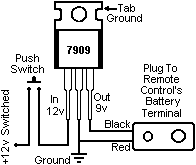If you are annoyed by staring at a garage door opener hanging from your sun visor or are concerned about someone breaking into your car, opening your garage door with the remote control and breaking into your house, you can easily rewire your remote and hide it under the dash.
Forget about changing batteries, convert the voltage from the car to drive the remote. Since the car’s accessory wire does not have power when the key is off, thieves will not be able to open the garage if they do break in your car.
Precautions
This procedure applies to remote openers that work with a 9-volt battery only. If your remote runs under a different voltage, the circuit will be different.
Extreme care must be taken when disassembling, testing and soldering. If not careful, you could damage the remote control.
To work on this project you should feel comfortable soldering, messing with a circuit board and have some basic tools such as a soldering iron or station (you can buy one for $10) and multimeter (voltmeter/ohmmeter).
Parts
7809 Positive 9-volt 1A voltage regulator
Push switch (normally open)
Small circuit board with holes (optional)
9-volt battery plug
Wires, electrical tape (or heatshrink)
Procedure
First, unplug and remove the battery, open the casing of the garage door opener remote control. Some units use screws and some are held together with pressure snaps.
Once you get the circuit board out, locate the pressure switch that activates the circuit. With an ohmmeter, test the metal terminals on the circuit board where the switch is located (most have more than two pins). You have to find two solder joints that get “connected” when the switch is pushed. If you are 100% sure you got the right tabs, hook up the battery to the remote and short briefly the two tabs with a wire. If the garage door opens and closes, you have found the right terminals.
Solder a wire to each of the two terminals at the switch in the circuit board. Be careful not to damage any components or short out any traces on the circuit board.
Mount a switch somewhere on the dash or console to operate the remote. Solder the two wires that bypass the remote control’s switch to the external switch.
 Build the circuit on the diagram (left) to step down the voltage from the vehicle’s 12 volts (the circuit works for up to 35 volts) to 9 volts. Make sure that the battery plug is soldered BACKWARDS to the circuit (black to +12v ignition and red to ground). Once the circuit is built, hook it up to the car’s ignition (key on) output and test output voltage and polarity with a voltmeter.
Build the circuit on the diagram (left) to step down the voltage from the vehicle’s 12 volts (the circuit works for up to 35 volts) to 9 volts. Make sure that the battery plug is soldered BACKWARDS to the circuit (black to +12v ignition and red to ground). Once the circuit is built, hook it up to the car’s ignition (key on) output and test output voltage and polarity with a voltmeter.
If the voltage is 9 volts and polarity is correct, plug up the voltage regulation circuit to the remote’s battery terminal. Test to make sure everything works. Wrap up the circuit in electrical tape or heat shrink to avoid shorts. Finally, hide the remote under the dash or somewhere else.